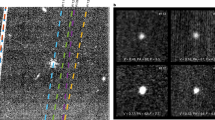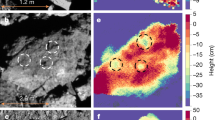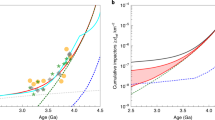Abstract
RECENT observations with the Spacewatch telescope indicate that the flux of Earth-crossing objects with diameters below about 50 m is some 10–100 times higher than predicted by simple extrapolation from the known main-belt asteroid population1,2. This might seem to imply3 a significantly greater terrestrial hazard from atmospheric explosions such as those that occurred over Revelstoke or Tunguska4,5. Here I show that explosions due to Spacewatch objects with diameters less than 50 m (having kinetic energies below about 10 megatonnes high-explosive equivalent) typically occur too high in the atmosphere to cause substantial surface damage. Exclusive of relatively rare iron objects, no comet or asteroid with an energy below ∼2 megatonnes threatens the Earth's surface. The high flux of small Earth-crossing objects identified by Spacewatch therefore does not imply a greater terrestrial hazard.
This is a preview of subscription content, access via your institution
Access options
Access to this article via Institution of Civil Engineers Library is not available.
Subscribe to this journal
Receive 51 print issues and online access
$199.00 per year
only $3.90 per issue
Buy this article
- Purchase on SpringerLink
- Instant access to full article PDF
Prices may be subject to local taxes which are calculated during checkout
Similar content being viewed by others
References
Rabinowitz, D.L. Astrophys. J. 407, 412–427 (1993)
Rabinowitz, D. L. et al. Nature 363, 704–706 (1993).
Ceplecha, Z. Astr. Astrophys. 263, 361–366 (1992).
Chyba, C. F., Thomas, P. J. & Zahnle, K. J. Nature 361, 40–44 (1993).
Morrison, D. et al. The Spaceguard Survey (NASA, 1992).
Öpik, E.J. Proc. R. Irish Acad. A54, 165–199 (1951).
Öpik, E. J. Interplanetary Encounters (Elsevier, New York, 1976).
Shoemaker, E. M. & Wolfe, R. F. in Satellites of Jupiter (ed. Morrison, D.) 277–339 (Univ. of Arizona, Tucson, 1982).
Shoemaker, E. M., Wolfe, R. F. & Shoemaker, C. S. in Global Catastrophes in Earth History (eds Sharpton, V. L. & Ward, P. D.) 155–170 (Geol. Soc. Am spec, publ 247, Boulder. 1990).
Chyba, C. F. Icarus 92, 217–233 (1991).
Shoemaker, E. M. Rev. Earth planet. Sci. 11, 461–494 (1983).
Hills, J. G. & Goda, M. P. Astr. J. 105, 1114–1144 (1993).
Broyles, A. A. Am. J. Phys. 50, 586–594 (1982).
Glasstone, S. & Dolan, P. J. The Effects of Nuclear Weapons (Dept of Defense, Washington DC, 1977).
Zotkin, I. T. & Tsikulin, M. A. Sov. Phys. Dokl. 11, 183–186 (1966).
Korobeinikov, V. P., Chushkin, P. I. & Shurshalov, L. V. Acta astronaut. 9, 641–643 (1982).
Wetherill, G. W. & Shoemaker, E. M. in Geological Implications of Impacts of Large Asteroids and Comets on the Earth (eds Silver, L. T. & Schultz, P. H.) 1–13 (Geol. Soc. Am. spec. Publ 190, Boulder, 1982).
Gaffey, M. J., Bell, J. F. & Cruikshank, D. P. in Asteroids II (eds Binzel, R.P., Gehrels, T. & Matthews, M.S.) 98–127 (Univ. of Arizona, Tucson, 1989).
McFadden, L., Tholen, D. J. & Veeder, G. J. in Asteroids II (eds Binzel, R. P., Gehrels, T. & Matthews, M. S.) 442–467 (Univ. of Arizona, Tucson, 1989).
Passey, Q. R. & Melosh, H. J. Icarus 42, 211–233 (1980).
Jacobs, C. & Spalding, R. in Con. Abst. Hazards Due to Comets and Asteroids (ed. Gehreis, T.) 45 (Univ. of Arizona, Tucson, 1993).
Author information
Authors and Affiliations
Rights and permissions
About this article
Cite this article
Chyba, C. Explosions of small Spacewatch objects in the Earth's atmosphere. Nature 363, 701–703 (1993). https://doi.org/10.1038/363701a0
Received:
Accepted:
Issue Date:
DOI: https://doi.org/10.1038/363701a0



